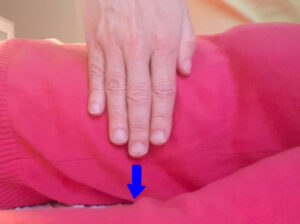UNDERSTANDING THE READING GRID
Following the example of Japanese medicine, we remind you of the importance of palpating points, channels and tissues of the human body in diagnosis and treatment. However, it is necessary to know HOW to palpate and WHERE to palpate.
The reading grid of the tissues is a set of manual controls which makes it possible to determine where the body is in need at a given moment (at the point of the examination), which is the disturbed energetic function(s) and at which level (the Five Shu points, Luo points, Back-Shu/ Front-Mu points, Extraordinary Channels, emotional chain of the Stomach, of the Gall bladder, chain of the Spleen, outrer pathway of the Bladder channel, teeth, physical traumatisms…). It is the body that shows where it is in demand and not the therapist who decides what it is good to do for the patient.
We will illustrate our point by studying a few CENTRES in the reading grid
Observations and palpatory research have enabled us to determine regions of the body called “centres” which are both ENTRY DOORS and CORRECTION AREAS. Each centre controls one or more energy levels.
In photo 1, the location of the centres and the therapeutic levels or energy functions they control. The control of the centres is done through a horizontal transversal interrogation on the surface (epidermis) with the last 4 fingers placed flat.

THE LEFT THORACIC CENTRE controls :
a) the Shu points of Jing Bie ( classic Shu points such as 13V, 15V, 18V…)
b) the function Back-Shu points (UB 11 UB 12, UB 14…)
c) the Jing Bie Front-Mu points of Jing Bie ( classic Front-Mu points)
The blockage of this centre indicates a disturbance in at least 1 of these 3 therapeutic levels, on the right or on the left. If there is no blockage in the centre, it means that this is not where the body is in demand, the therapist then moves on to control the next centre
If there is a blockage in this centre, specific controls determine first the therapeutic level that is disturbed and then, within this level, the energetic function (Liver, Spleen, Stomach…) to be treated. Each point having a particular energetic orientation (example: UB 13->LU, UB 15->HT, UB 18->LV…) it is easy to find the point to be corrected, which will moreover be closed (it does not answer a vertical interrogation on the surface). To make corrections, the general rule is to connect the point with the centre.

THE VERTEX CENTRE controls the 3 emotional chains of the Du Mai, Stomach and Gallbladder channels, as well as the cephalic control points of the Extraordinary Channels (from GB 1 to GB 9- current GB 13). The chains are located on the lower channels, at the level of the trunk and the head. On a chain, each point is related to an organ or a viscera, as the classic Back-Shu points of the inner pathway of the UB channel. A blockage of the centre indicates a disturbance in at least 1 emotional chain or in the cephalic control points of the Extraordinary Channels. The interrogation of the half-centre makes it possible to determine the laterality of the blockage.

Control of the vertex centre

Correction of ST 14
The point/organ correspondences were established by Jacques Pialoux (“Guide to Acupuncture and Moxibustion”, ed. Cornelius Celsus Foundation). The corrections that we propose based on his decodings confirm their accuracy.
In the reading grid, in addition to the centres, so-called complementary tests make it possible to control the other therapeutic levels.
